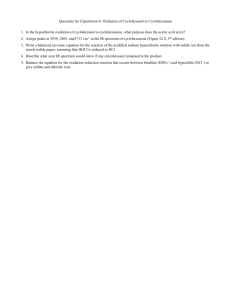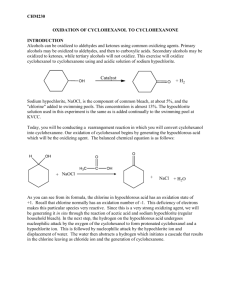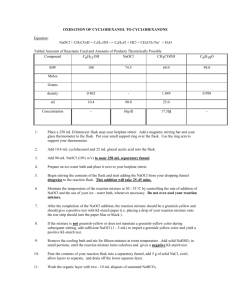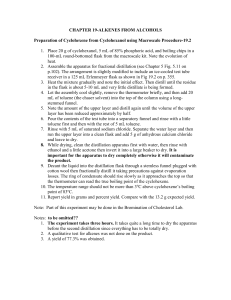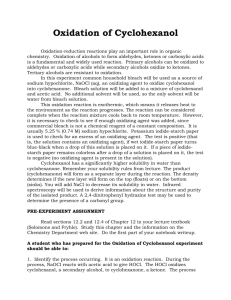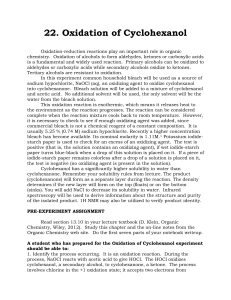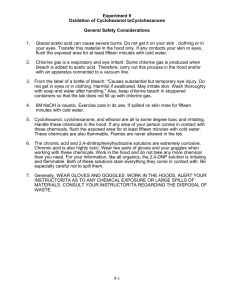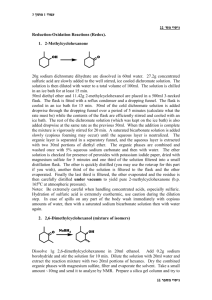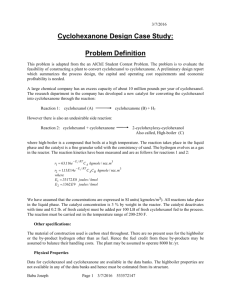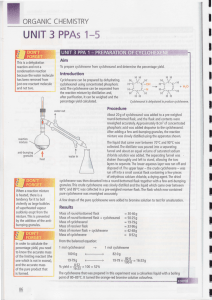Experiment 9 - Chemistry Solutions
advertisement
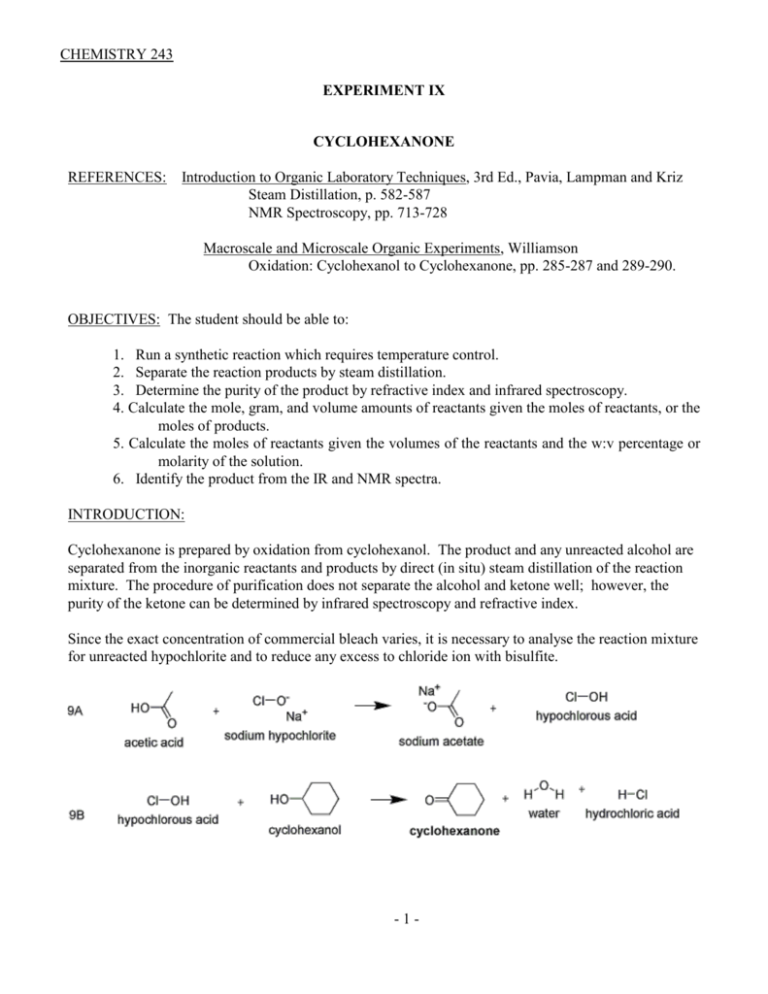
CHEMISTRY 243 EXPERIMENT IX CYCLOHEXANONE REFERENCES: Introduction to Organic Laboratory Techniques, 3rd Ed., Pavia, Lampman and Kriz Steam Distillation, p. 582-587 NMR Spectroscopy, pp. 713-728 Macroscale and Microscale Organic Experiments, Williamson Oxidation: Cyclohexanol to Cyclohexanone, pp. 285-287 and 289-290. OBJECTIVES: The student should be able to: 1. Run a synthetic reaction which requires temperature control. 2. Separate the reaction products by steam distillation. 3. Determine the purity of the product by refractive index and infrared spectroscopy. 4. Calculate the mole, gram, and volume amounts of reactants given the moles of reactants, or the moles of products. 5. Calculate the moles of reactants given the volumes of the reactants and the w:v percentage or molarity of the solution. 6. Identify the product from the IR and NMR spectra. INTRODUCTION: Cyclohexanone is prepared by oxidation from cyclohexanol. The product and any unreacted alcohol are separated from the inorganic reactants and products by direct (in situ) steam distillation of the reaction mixture. The procedure of purification does not separate the alcohol and ketone well; however, the purity of the ketone can be determined by infrared spectroscopy and refractive index. Since the exact concentration of commercial bleach varies, it is necessary to analyse the reaction mixture for unreacted hypochlorite and to reduce any excess to chloride ion with bisulfite. -1- REAGENTS: Reactants: Cyclohexanol and Sodium hypochlorite (commercial bleach solution 5.25% NaClO or 0.75 M) Initiator: Glacial acetic acid - 6 ml 1 Calculate the amount of cyclohexanol required to yield 0.100 moles of cyclohexanone, assuming a 100% yield. Use this theoretical amount of cyclohexanol. Use 155 ml of commercial bleach solution; calculate the mole quantity used. Calculate the mole ratios of the reactants used. When calculating amounts of reactants, round final masses to 1 decimal place and final volumes to whole numbers. APPARATUS: A 300 ml round-bottom flask with thermometer well A 250 ml dropping funnel (Separatory funnel used for reagent addition) DIRECTIONS: Add the cyclohexanol and glacial acetic acid to the 300 ml flask. Insert an alcohol thermometer in a neoprene themometer adaptor into the side well so the bulb is in the liquid. Add the entire volume of bleach to the dropping funnel and position above the flask with the spout of the funnel in the neck of the flask. The bleach is added dropwise to the flask via the dropping funnel with constant vigorous swirling. The rate should be fast enough to cause the temperature of the mixture to increase slowly. Optimum temperature for the reaction is between 40 oC and 50 oC; this range can be maintained by increasing the addition rate or cooling in an ice bath. After all of the bleach solution has been added the reaction is allowed to stand with occasional swirling for 20 minutes. To test for unreacted hypochlorite, add 3 drops of the aqueous layer of the reaction mixture to one well of a drop plate and add 2 drops of starch/KI solution. The presence of hypochlorite is seen by the blueblack color of iodine/starch complex. If hypochlorite is present, add 1 ml portions of a saturated sodium bisulfite solution to the reaction mixture, mix well and retest until a negative test is obtained. -2- The reaction mixture is transferred to a 500 ml round bottom flask, rinsing the reaction flask twice with 25 ml portions of water and adding the rinses to the 500 ml flask. Using a simple distillation apparatus the mixture is direct steam distilled until the distillate in the condenser is a single phase and the liquid remaining in the pot is clear. The aqueous layer is saturated with sodium chloride ( add 5 gm portions and swirl until the mixture is saturated). The cyclohexanone is separated, and the aqueous layer extracted with ether (10 ml of ether is probably enough). The combined cyclohexanone and ether extract are dried over anhydrous magnesium sulfate and the magnesium sulfate filtered off. The solution is placed in a 125 ml suction flask and the ether evaporated off by use of a suction set up. The remaining liquid is transferred to a distilling flask and distilled. Cyclohexanone is collected at 140 - 155 oC. The refractive index and infrared spectrum of the product are determined. From the refractive index, boiling point, infrared spectrum and NMR spectrum the product is identified. From the refractive index and infrared spectrum the product purity is determined. All physical constants are reported. Note 1: The glacial acetic acid serves as an intiator in the reaction, by reacting initially with the sodium hypochlorite to form hypochlorous acid. Once the reaction mixture is acidic from the generation of hydrochloric acid in the main reaction, the hypochlorous acid continues to be generated from sodium hypochlorite. TPS Revised 08/15 -3-
